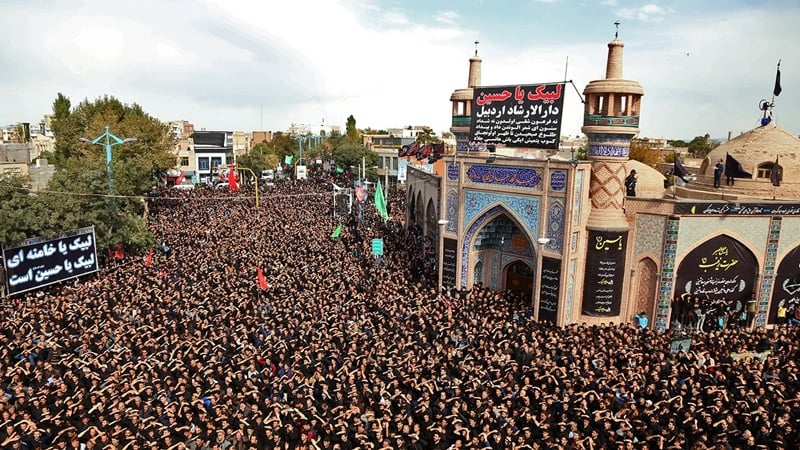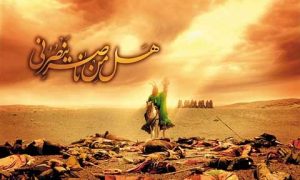The connection between the Muharram and seeking martyrdom forms a profound spiritual and motivational bedrock for Shia Islamic resistance movements globally. The month of Muharram, culminating in the commemoration of Ashura on the 10th day, marks the martyrdom of Imam Hussain ibn Ali (AS), the grandson of Prophet Muhammad (PBUH), and his small band of followers at the Battle of Karbala in 680 CE.
This event, far from being relegated to history, is a living, breathing narrative of sacrifice, defiance against tyranny, and the ultimate victory of principle over power through martyrdom.
The Connection Between the Muharram and Seeking Martyrdom
The connection between the Muharram and seeking martyrdom transforms grief into resolve, mourning into mobilization, and the memory of Karbala into a powerful paradigm that shapes the ethos, rhetoric, and willingness for self-sacrifice within groups engaged in asymmetrical struggles, particularly against forces perceived as oppressive or occupying.
This narrative provides not only a justification for resistance but also a transcendental framework that imbues the act of martyrdom with deep religious meaning and eternal reward, fostering a unique psychological resilience among fighters.
you can read more about this topic here.
Karbala: The Archetype of Sacrifice and Righteous Resistance
The tragedy of Karbala is the cornerstone. Faced with the vastly superior army of the Umayyad caliph Yazid I, who demanded allegiance despite his deviation from Islamic principles, Imam Hussain (AS) chose principled defiance.
Knowing the near-certainty of death for himself, his family, and his companions, he declared: “Death with dignity is better than a life of humiliation.”
The brutal massacre, including the killing of Hussain (AS) and the captivity of the women and children, is commemorated annually during Muharram. For Shia Muslims, Hussain is not merely a historical figure; he is the “Master of Martyrs” (Sayyid al-Shuhada).
His stand represents the eternal struggle of truth against falsehood, justice against oppression, and the willingness to offer everything, including life itself, to uphold divine principles and protect the faith.
Karbala establishes martyrdom (shahadat) not as defeat, but as the ultimate victory – a gateway to paradise and eternal proximity to God.
This foundational narrative directly informs the connection between the Muharram and seeking martyrdom in contemporary contexts.
Theological Foundations: Martyrdom (Istishhadi) in Shia Islam
Shia Islam possesses a rich theological discourse on martyrdom (shahadat) and the concept of actively seeking it (istishhadi), distinct from passive martyrdom. Key theological underpinnings include:
-
The Elevated Status of the Martyr (Shaheed): Numerous Quranic verses (e.g., 3:169-171) and Prophetic traditions emphasize the exalted status of martyrs. They are described as being alive in the presence of God, receiving boundless blessings, and interceding for others. This promise provides immense spiritual incentive.
-
Following the Path of Hussain (AS): Emulating Hussain’s sacrifice is seen as the highest form of devotion and a direct path to divine pleasure. Ashura rituals constantly reinforce this model of ultimate sacrifice for a sacred cause.
-
Redemptive Power: Martyrdom is believed to absolve sins and guarantee entry into paradise. In contexts of perceived oppression, it becomes an act of ultimate purification and devotion.
-
Defense of Religion and Community: Dying while actively defending Islam, the vulnerable, or the community (ummah) against aggression or injustice is considered a supreme form of martyrdom. This frames resistance against occupation or tyranny as a religious duty.
-
Eternal Victory over Oppression: Karbala teaches that physical death does not signify defeat if the cause is just. Yazid’s apparent victory was ephemeral; Hussain’s moral and spiritual victory endures. This reframes martyrdom in resistance as a strategic, albeit costly, act ensuring the long-term triumph of the cause.
The connection between the Muharram and seeking martyrdom draws directly from these theological tenets, providing a divine sanction and cosmic significance to the act of dying in resistance.
Muharram Rituals: Forging the Martyrdom Ethos
The annual commemoration of Muharram and Ashura is not passive mourning; it is a dynamic, immersive process that actively cultivates the values of sacrifice and remembrance of Karbala, reinforcing the connection between the Muharram and seeking martyrdom:
-
Majalis (Commemorative Gatherings): Religious sermons (rawda khwani) vividly recount the events of Karbala, focusing on the courage, faith, and sacrifice of Hussain and his companions. These narratives personalize the martyrdom, making it relatable and inspirational.
-
Lamentation and Mourning (Noha/Latmiya): Poetic recitations and rhythmic chest-beating express profound grief and solidarity with the sufferings of the Ahl al-Bayt (Family of the Prophet). This collective catharsis transforms sorrow into a powerful communal bond and shared resolve.
-
Taziyeh (Passion Plays): Re-enactments of Karbala immerse participants emotionally and psychologically in the narrative. Seeing the story dramatized reinforces the immediacy of the sacrifice and the villainy of the oppressor.
-
Processions (Juloos/Ashura Processions): Public marches, often involving symbolic representations of coffins (nakhl or ta’ziyeh) and self-flagellation rituals (like zanjeer zani – chain beating, though practices vary), physically embody grief and devotion. They publicly affirm loyalty to Hussain’s cause and demonstrate willingness to endure pain in his remembrance.
-
Visitation (Ziyarat) of Shrines: Pilgrimage to the shrines of Imam Hussain (AS) in Karbala, Iraq, and other Imams reinforces the tangible connection to martyrdom and serves as a powerful spiritual recharge, especially for fighters.
Through these intense, multi-sensory rituals, participants internalize the Karbala paradigm. The message is clear: remembrance is insufficient; true loyalty requires emulation. The willingness to sacrifice becomes a core identity marker for the faithful, particularly in contexts of conflict.
Manifestations in Resistance Movements
The connection between the Muharram and seeking martyrdom finds concrete expression in the ideology, propaganda, and actions of several Shia resistance groups:
-
Hezbollah (Lebanon): Founded with strong ideological ties to Iran’s Islamic Revolution, Hezbollah explicitly draws on the symbolism of Ashura. Its anthem references Karbala. Leaders frequently invoke Hussain’s sacrifice in speeches, framing their struggle against Israeli occupation as a continuation of his stand. Martyrs (shuhada) are venerated publicly with posters and ceremonies steeped in Muharram imagery. The group’s signature tactic – suicide operations against high-value Israeli targets during its formative years – was explicitly framed as istishhadi operations, directly linking the act to the Karbala ethos. This spiritual motivation is credited as a key factor in their resilience against a technologically superior adversary.
-
Popular Mobilization Forces (PMF – Iraq): Formed to combat ISIS, many Shia brigades within the PMF (like Kata’ib Hezbollah, Asa’ib Ahl al-Haq) are deeply influenced by the Karbala narrative. Fighters often participated in Ashura processions before deployment. Battle cries invoke Hussain and Karbala. Martyrdom is actively sought and celebrated as the highest honor, with fallen fighters referred to as “Hussaini martyrs.” Videos and propaganda frequently juxtapose images of fighters with icons of Imam Hussain. The connection between the Muharram and seeking martyrdom provided crucial morale during the brutal battles against ISIS, framing the fight as a sacred defense against a modern-day Yazid.
-
Islamic Revolutionary Guard Corps (IRGC – Iran) & Quds Force: As the ideological vanguard of Iran’s revolution, the IRGC inculcates the Karbala ethos deeply within its ranks. The Iran-Iraq War (1980-88) saw massive mobilization framed explicitly through the lens of Ashura. Human wave attacks and willingness for martyrdom were actively encouraged using Muharram symbolism. Annual commemorations glorify war martyrs alongside Hussain. The Quds Force, operating externally, propagates this ideology among allied groups, emphasizing sacrifice for the wider Islamic cause.
-
Palestinian Resistance (Certain Factions): While predominantly Sunni, some Palestinian factions with Shia links or influenced by the broader “Axis of Resistance” (supported by Iran) have adopted aspects of this narrative. Groups like Palestinian Islamic Jihad (PIJ) explicitly reference Karbala in their discourse on martyrdom operations (amaliyat istishhadiyya), framing their struggle against Israeli occupation within the paradigm of resisting oppression.
Psychological and Operational Impact
The connection between the Muharram and seeking martyrdom translates into tangible military and psychological advantages for resistance forces:
-
Unmatched Morale and Resilience: The belief in divine reward and the eternal victory of the martyr creates a psychological shield against fear of death. Fighters demonstrate extraordinary resilience, enduring hardship and engaging in high-risk operations that conventional armies might avoid.
-
Willingness for High-Risk/Sacrificial Tactics: The Karbala narrative explicitly valorizes sacrificing one’s life for the cause. This enables the adoption of tactics like suicide bombings (historically), complex ambushes against superior forces, or holding defensive positions against overwhelming odds – tactics where survival is secondary to inflicting damage or defending principle.
-
Strong Group Cohesion and Identity: Shared participation in intense Muharram rituals creates powerful in-group bonds and a collective identity centered on sacrifice and resistance. This fosters unit cohesion, loyalty, and mutual support in combat.
-
Legitimization and Recruitment: Framing resistance as a sacred duty in emulation of Hussain provides powerful religious legitimacy, attracting recruits motivated by faith and the desire for eternal reward. The veneration of martyrs serves as a potent recruitment tool.
-
Psychological Warfare: The adversary faces fighters who do not fear death in the conventional sense. This can be demoralizing for conventional forces, who struggle to comprehend or counter an enemy motivated by transcendent beliefs. The spectacle of Ashura commemorations also serves as a constant reminder to adversaries of the deep well of resolve they face.
Controversies and Critiques
The connection between the Muharram and seeking martyrdom is not without significant controversy and critique:
-
Exploitation Concerns: Critics argue political and military leaders exploit deep religious sentiments for strategic goals, potentially sending young men to their deaths based on emotional manipulation of sacred symbols.
-
Theology of Martyrdom: Some Islamic scholars, particularly Sunni, contest the Shia interpretation of istishhadi (actively seeking martyrdom), arguing that while dying in legitimate defense is martyrdom, actively pursuing death is theologically problematic. They differentiate between defensive martyrdom and offensive suicide operations.
-
“Cult of Death” Accusation: Opponents often frame this ethos as a “cult of death,” arguing it glorifies violence and devalues earthly life, hindering political solutions and perpetuating cycles of conflict. They contrast it with narratives prioritizing life, peacebuilding, and political negotiation.
-
Civilian Cost: Tactics associated with martyrdom-seeking, particularly historical suicide bombings in civilian areas (though largely abandoned by major Shia groups now), have resulted in significant non-combatant casualties, drawing widespread condemnation and accusations of terrorism.
-
Internal Debate: Within Shia communities, debates exist about the appropriate interpretation and application of the Karbala narrative in modern politics and warfare, balancing spiritual inspiration with ethical conduct and the preservation of life where possible.
Conclusion: An Enduring Paradigm
The connection between the Muharram and seeking martyrdom remains a potent and defining force within Shia Islamic resistance movements.
The tragedy of Karbala, relived annually through the rituals of Ashura, is far more than a historical commemoration; it is an active engine generating spiritual meaning, moral legitimacy, and unparalleled psychological fortitude.
It provides fighters with a framework that transforms the horror of death in battle into a sacred act of ultimate devotion and victory.
This deeply ingrained belief system, centered on emulating Imam Hussain’s stand against tyranny, fosters a culture of sacrifice and resilience that has proven decisive in asymmetrical conflicts.
While fraught with theological, ethical, and political complexities, the power of this connection is undeniable. It shapes identities,
motivates actions, and ensures that the cry of “Every day is Ashura, every land is Karbala!” continues to resonate wherever individuals perceive themselves as standing against oppression, drawing strength from the eternal connection between the Muharram and seeking martyrdom.
source: raialkhalij




